英文书法作品欣赏鸟类
caged bird诗歌鉴赏
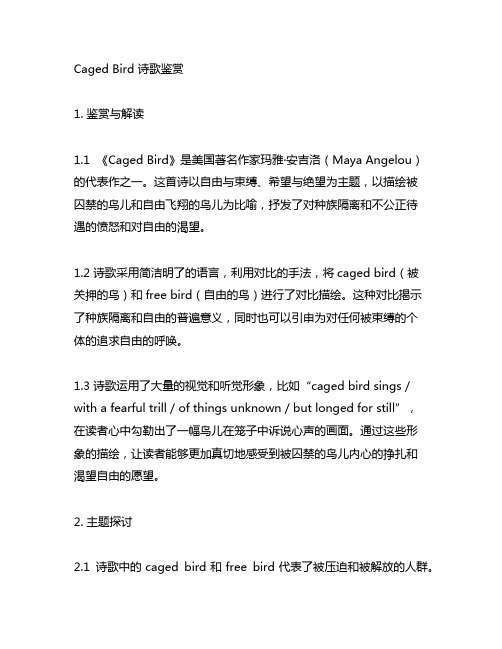
Caged Bird 诗歌鉴赏1. 鉴赏与解读1.1 《Caged Bird》是美国著名作家玛雅·安吉洛(Maya Angelou)的代表作之一。
这首诗以自由与束缚、希望与绝望为主题,以描绘被囚禁的鸟儿和自由飞翔的鸟儿为比喻,抒发了对种族隔离和不公正待遇的愤怒和对自由的渴望。
1.2 诗歌采用简洁明了的语言,利用对比的手法,将caged bird(被关押的鸟)和free bird(自由的鸟)进行了对比描绘。
这种对比揭示了种族隔离和自由的普遍意义,同时也可以引申为对任何被束缚的个体的追求自由的呼唤。
1.3 诗歌运用了大量的视觉和听觉形象,比如“caged bird sings / with a fearful trill / of things unknown / but longed for still”,在读者心中勾勒出了一幅鸟儿在笼子中诉说心声的画面。
通过这些形象的描绘,让读者能够更加真切地感受到被囚禁的鸟儿内心的挣扎和渴望自由的愿望。
2. 主题探讨2.1 诗歌中的caged bird和free bird代表了被压迫和被解放的人群。
caged bird面临的是种种束缚和压抑,而free bird则可以自由飞翔于天空。
这可以被理解为对种族隔离历史的讽刺,也可以被理解为对任何追求自由的个体的呼唤。
2.2 诗歌通过对caged bird的描绘,呼应了当时美国南方种族隔离的社会现实,也对种族歧视的不公进行了深刻的讽刺和揭露。
2.3 通过free bird的形象,诗歌也传递出了对自由、平等和尊严的向往,呼吁人们勇敢追求和捍卫自由与尊严。
3. 个人观点3.1 《Caged Bird》通过简练清晰的语言,深刻地揭示了当时美国南方种族隔离的社会现实,呼吁人们勇敢追求自由与尊严。
3.2 诗歌将被囚禁的鸟儿描绘得极其生动和真切,深深触动了我对于自由和平等的向往。
无论是在种族、信仰还是性别等方面的不公,都应该引起我们的反思和行动。
英文草体字大全书法

英文草体字大全书法
英文草体字是一种书法风格,将英文字母以草书的形式书写。
草书是中国传统书法中的一种风格,其特点是笔画激荡、连绵流畅,给人一种自由奔放的感觉。
在书写英文草体字时,可以借鉴草书的
笔法和结构,将英文字母书写得更加独特和艺术化。
在英文草体字大全书法中,可以包含所有的英文字母,从A到Z,以及大小写形式。
每个字母都可以采用草书的笔画特点,如连笔、断笔、勾画等,以增加书写的艺术感和独特性。
书写英文草体字时,可以尝试不同的笔画风格和结构,以展现
个人的艺术风格和创造力。
可以运用草书的特点,如流畅的曲线、
交错的笔画和变化的厚薄,来书写英文字母,使其更加生动有趣。
此外,英文草体字大全书法也可以包括一些常见的词组、名言
警句或个人标语等。
通过将这些词组书写成草体字的形式,不仅可
以展示书法的艺术魅力,还可以传达出一种独特的思想和情感。
总而言之,英文草体字大全书法是一种将英文字母以草书形式
书写的艺术表达方式。
通过运用草书的笔法和结构,可以创造出独
特而有趣的英文书法作品。
这种书法风格不仅展现了个人的艺术才华,还丰富了英文字母的表现形式,给人一种全新的视觉体验。
世界最伟大的鸟类图谱《鸟类圣经》2
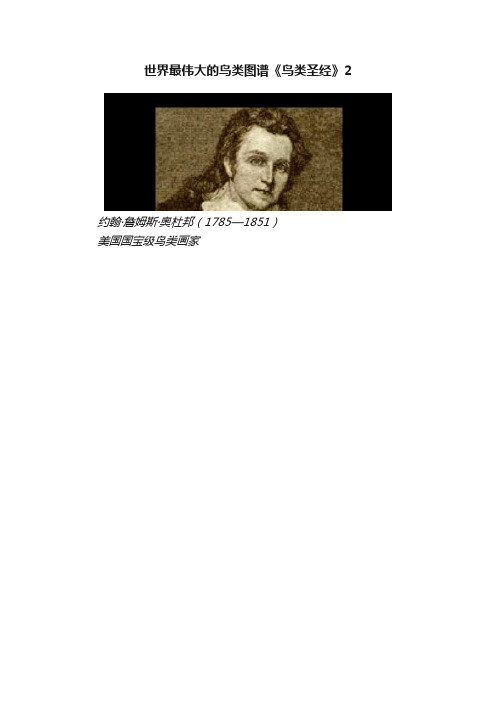
世界最伟大的鸟类图谱《鸟类圣经》2约翰·詹姆斯·奥杜邦(1785—1851)美国国宝级鸟类画家菲比霸蓊学名:Sayornis saya英文名:Say’s Flycatcher1雄性,2雌性菲比霸蓊长相类似于捕蝇鸟,长期生活在水边,以小飞虫为食。
它的喙为黑色,窄而尖。
背部为褐色,翅膀黑色,羽毛的边缘有褐色或白色的窄条纹。
尾羽黑色。
腹部黄褐色,胸部呈苍白色。
腿爪黑色。
它们在悬崖的缝隙间筑巢。
在遇到人之后总是显得很胆怯,而且比较沉默。
山岩捕蝇鸟学名:Sayornis nigricans英文名:Rocky Mountain Flycatcher雄性山岩捕蝇鸟的头和背部就像黑烟煤熏黑了的褐色,翅膀和尾羽颜色稍深,二级羽和三级羽有白色的边。
腹部白色,腿和爪子纤细锐利,为灰色。
山岩捕蝇鸟和其他捕蝇鸟比起来似乎更善于利用翅膀,它能敏捷地捉住昆虫并咬断它们的翅膀。
在袭击小飞虫时,它会使出各式各样的特技表演,就好像在空中舞蹈。
图中的树木为槲栎。
阿卡迪亚捕蝇鸟学名:Empidonax virescens英文名:Small Green-crested Flycatcher1雄性、2雌性阿卡迪亚捕蝇鸟的头部、背部为暗褐色,翅膀和尾羽的羽毛有淡褐色的边,咽喉灰白色,腹部呈微黄的白色。
阿卡迪亚捕蝇鸟的喙为红色,眼周有黄色的眼圈。
阿卡迪亚捕蝇鸟喜欢在一些干的小树枝上栖息,并耐心地观察着虹膜周围的物体,当它感觉到有一只昆虫就在附近的时候,就果断出击。
图中的树木为檫木。
美洲小燕雀学名:Empidonax minimus英文名:Pewee Flycatcher1雄性、2雌性美洲小燕雀的头顶有凸起的羽毛,酷似鱼鳍。
背部和翅膀呈深褐色,翅膀的羽毛有淡褐色的边,腹部为白色。
美洲小燕雀喜欢在树林中生活。
与定点捕食的其他捕蝇鸟不同的是,有时美洲小燕雀在猎物与它有一定距离的时候会跟踪猎物,有时也会在树丛中寻找猎物。
图中的植物为棉花。
英文书法临摹

英文书法临摹Tracing and imitating English calligraphy is an enchanting journey that combines the elegance of handwriting with the uniqueness of artistic expression. It is a skill that requires patience, precision, and an appreciation for the beauty of letters formed with a pen or brush. The art of English calligraphy is not just about writing legibly; it's about creating masterpieces that capture the essence of each letter and convey a sense of style and personality.Tracing is often the first step for beginners in the world of calligraphy. It involves following the contours of pre-printed letters or templates, allowing individuals to familiarize themselves with the strokes, curves, and serifs that make up each character. This process helps develop muscle memory and a sense of control over the instrument being used, whether it's a fountain pen, a dip pen, or even a brush.As beginners progress, they transition to imitating, which involves replicating calligraphic styles without the aid of templates. This phase requires a deeperunderstanding of the structure and proportions of each letter, as well as an appreciation for the overall flow and rhythm of the text. Imitating allows calligraphers to express their creativity and personal style, making each piece unique and reflecting the artist's individuality.The tools of the trade are crucial in the art ofEnglish calligraphy. High-quality pens, inks, and papersare essential for achieving the desired effects. Fountain pens, with their smooth ink flow and precise nibs, are popular choices for calligraphy. Inks come in a variety of colors and finishes, ranging from rich blacks and deepblues to shimmering metallics and iridescent sheens. Papers, too, play a vital role, as they affect the spread anddrying time of the ink, influencing the final look and feel of the calligraphy.In addition to the physical tools, the calligrapher's mindset is equally important. Patience and practice are key, as calligraphy is a skill that takes time to master. Calligraphers must be willing to experiment, try new styles, and embrace failure as part of the learning process. They must also cultivate an appreciation for the art form,understanding that calligraphy is not just about writingbut about creating beautiful works of art.The benefits of tracing and imitating Englishcalligraphy are numerous. They include improved handwriting skills, enhanced concentration and focus, and a deeper appreciation for the art of writing. Calligraphy can also serve as a form of relaxation and stress relief, as the act of creating beautiful letters can be meditative and calming. In conclusion, tracing and imitating Englishcalligraphy are essential steps in the journey of mastering this ancient art form. They require dedication, practice, and an appreciation for the beauty of handwritten letters. As calligraphers progress, they not only improve their handwriting skills but also cultivate a deeperunderstanding and appreciation for the art of writing. English calligraphy, with its unique blend of precision and creativity, offers a rewarding and enriching experience for those willing to embark on this enchanting journey.**英文书法临摹:艺术与技巧的融合**英文书法临摹是一场迷人的旅程,它将手写的优雅与独特的艺术表达相结合。
与龙有关的英语书法作品
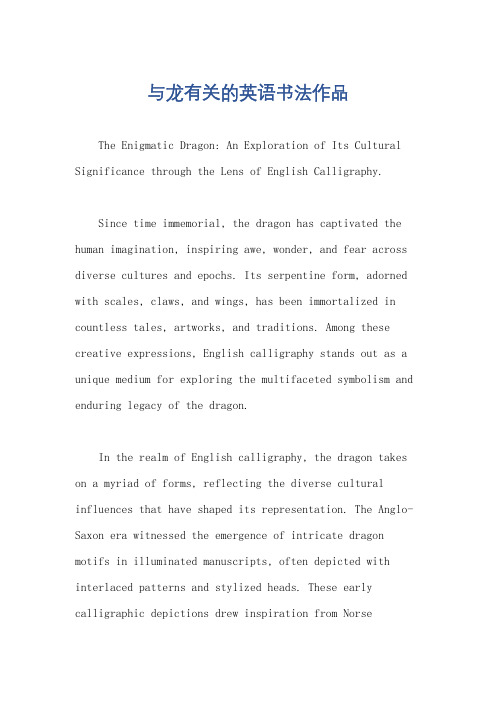
与龙有关的英语书法作品The Enigmatic Dragon: An Exploration of Its Cultural Significance through the Lens of English Calligraphy.Since time immemorial, the dragon has captivated the human imagination, inspiring awe, wonder, and fear across diverse cultures and epochs. Its serpentine form, adorned with scales, claws, and wings, has been immortalized in countless tales, artworks, and traditions. Among these creative expressions, English calligraphy stands out as a unique medium for exploring the multifaceted symbolism and enduring legacy of the dragon.In the realm of English calligraphy, the dragon takes on a myriad of forms, reflecting the diverse cultural influences that have shaped its representation. The Anglo-Saxon era witnessed the emergence of intricate dragon motifs in illuminated manuscripts, often depicted with interlaced patterns and stylized heads. These early calligraphic depictions drew inspiration from Norsemythology, where dragons were revered as powerful and enigmatic creatures.As Christianity spread throughout England, the dragon underwent a gradual transformation in calligraphic art. It became associated with evil and temptation, as exemplified in the portrayal of Saint George slaying a dragon in the famous illuminated manuscript, the Luttrell Psalter (c. 1340). The dragon's fiery breath and serpentine form became symbols of the perils of sin and the need for redemption.The Renaissance brought about a renewed appreciationfor classical art and literature, which in turn influenced the representation of dragons in English calligraphy. Humanist scribes drew inspiration from ancient Greek and Roman texts, where dragons were often depicted as guardians of treasure or symbols of wisdom. The works of Geoffrey Chaucer, particularly "The Canterbury Tales," featuredvivid descriptions of dragons that captured the imagination of calligraphers.During the Victorian era, the dragon experienced arevival of interest in both literature and art.Calligraphers embraced the Gothic Revival style, incorporating intricate dragon motifs into illuminated manuscripts and decorative objects. The works of William Morris, Edward Burne-Jones, and Dante Gabriel Rossetti showcased dragons as symbols of both beauty and danger, reflecting the Victorian fascination with the medieval and the exotic.In contemporary English calligraphy, the dragon continues to be a popular subject for exploration. Calligraphers draw inspiration from a wide range of sources, including fantasy literature, folklore, and ancient mythology. The use of vibrant colors, expressive brushstrokes, and innovative lettering techniques allows contemporary calligraphers to capture the essence of the dragon in fresh and captivating ways.The enduring presence of the dragon in English calligraphy reflects its enduring cultural significance. As a symbol of power, wisdom, danger, and temptation, the dragon has resonated with artists and audiences alikethroughout history. Through the medium of calligraphy, the dragon has found a unique and enduring form of expression, allowing us to delve into its enigmatic nature and explore its multifaceted symbolism.In the following paragraphs, we will explore specific examples of English calligraphy that showcase the dragon's multifaceted representation:1. Anglo-Saxon Dragon Motifs: The Lindisfarne Gospels(c. 698-700) is an illuminated manuscript that contains intricate dragon motifs within its text. The dragons are depicted with stylized heads and interlaced patterns, reflecting the influence of Norse mythology and Anglo-Saxon artistic traditions.2. Medieval Dragon Slayer: The Luttrell Psalter (c. 1340) features a full-page miniature of Saint George slaying a dragon. The dragon is depicted with a serpentine form, sharp claws, and a fiery breath, symbolizing the dangers of sin and the power of redemption.3. Renaissance Dragon Guardian: In the Ellesmere Manuscript of Chaucer's "Canterbury Tales" (c. 1410), dragons are depicted as guardians of treasure. The dragons are rendered in a naturalistic style, with vibrant colors and expressive brushstrokes, reflecting the influence of classical art and literature.4. Victorian Gothic Dragon: The works of William Morris, Edward Burne-Jones, and Dante Gabriel Rossetti often featured dragons as symbols of both beauty and danger. The dragons in these calligraphic works are depicted with intricate patterns, rich colors, and flowing lines, capturing the Gothic Revival style's fascination with the medieval and the exotic.5. Contemporary Dragon Interpretations: Contemporary calligraphers continue to explore the dragon's symbolism in innovative ways. Some calligraphers use abstract brushstrokes and vibrant colors to create dynamic interpretations of the dragon's form. Others incorporate elements of fantasy literature and folklore to createunique and captivating dragon designs.Through the lens of English calligraphy, the dragon emerges as a creature of endless fascination and enduring cultural significance. Its representation in illuminated manuscripts, decorative objects, and contemporary artworks reveals the profound impact it has had on human imagination throughout history. As an enigmatic symbol of power, wisdom, danger, and temptation, the dragon continues to inspire wonder and inspire creativity in the world of English calligraphy.。
英语书法作品范文

英语书法作品范文书法是汉字文化的重要组成部分,是中国传统文化的瑰宝,随着时代的推移,它已经成为了一种艺术表现形式,展示着中国文化的博大精深。
下面,我将为大家介绍几位著名的英语书法大师及其作品。
第一位大师是张宏伟,张宏伟是英国爱丁堡大学汉语言文化系教授、英国汉字艺术研究中心主任、英国国际汉字书法院院士。
他的作品以传统中国书法的韵味为基础,融入了现代书法的特点,全面展现了英语和汉字的奇妙融合。
他的书法作品流畅自然,富有节奏感和韵律感,表现出了我们中华民族的文化底蕴和时代精神。
第二位大师是盖居福,他是英国籍华人,是一位多才多艺的艺术家,他的书法作品非常有创意,既有中国书法的传统特点,也有时代气息。
他独特的风格深受众多书法爱好者喜爱,他的作品被誉为“汉字的魔法和英文的灵魂”。
他的作品给人以轻盈的感觉,字体内敛却又自由自在,表现出了人与自然、神和物的和谐。
第三位大师是田英章,在国际书坛上享有很高的声誉,他的书法作品独具匠心,将英语和中文完美地结合起来。
他的作品既有传统中国书法的笔法,又有现代设计的元素,呈现出了独特的现代书法风格。
他的作品往往给人留下深刻印象,让人们感受到书法的无穷魅力。
第四位大师是李锦和,他是曾经在英国伦敦的中国艺术学院教过书法,他的书法作品兼具中国传统的艺术美和现代艺术的审美需求,形式上既有传统的线条优美,又无限延伸,引领观众进入灵感、自然和散发的清晨感受。
他的作品大胆创新,结合了大量的西方艺术元素,使得他的书法作品呈现出更丰富多彩的风貌。
以上是我向大家介绍的几位英语书法大师,他们的作品展现了中西艺术的融合,每一幅作品都蕴含着深刻的文化内涵,让人们领略到书法艺术的无限魅力。
书法是及其艺术表现形式,随着时代的推移,它会不断地演进和发展,成为时代精神的表达。
让我们一起继承和发扬书法艺术,为人类的艺术发展作出更加重要的贡献。
三年级下册英语书法作品

三年级下册英语书法作品In the world of calligraphy, the art of writing in English often goes unnoticed. However, when it comes to the calligraphy of the third-grade English textbooks, the beauty and elegance of the letters come to the fore. This article explores the charm of English calligraphy in the context of the third-grade textbooks, highlighting its importance in the learning process and the skills it cultivates among students.The English alphabet, with its 26 letters, offers a vast canvas for creative expression. In the third-grade textbooks, the letters are introduced in a systematic manner, starting with the basics and gradually progressing to more complex forms. This gradual progression allows students to build a solid foundation in letter formation while encouraging them to experiment and express their individuality through their writing.The beauty of English calligraphy lies in itssimplicity and elegance. Each letter, when written correctly, has its own unique shape and flow. The curves and straight lines of the letters complement each other,creating a harmonious composition that is both visually appealing and easy to read. This harmonious balance between form and function is what makes English calligraphy so captivating.In the third-grade textbooks, the focus is not just on writing the letters correctly but also on understanding their shapes and sounds. This integrated approach helps students develop a deeper understanding of the English language, enabling them to associate each letter with its corresponding sound and meaning. This association not only improves their reading and writing skills but also enhances their comprehension and vocabulary.Moreover, practicing English calligraphy helps students develop fine motor skills and hand-eye coordination. The precision required in writing each letter helps strengthen the muscles in the hands and fingers, improving their dexterity and control. This, in turn, enhances theirability to perform other tasks that require fine motor skills, such as drawing or manipulating small objects.The practice of English calligraphy also fosters patience and discipline among students. Writing each letterwith care and precision requires a lot of concentration and effort. Over time, this practice helps students develop a sense of calmness and focus, enabling them to sit for longer periods without getting distracted. This improved concentration and focus benefits them in all areas of their academic and personal life.In conclusion, the English calligraphy found in third-grade textbooks is not just about writing beautifully; it is about developing a comprehensive understanding of the English language, enhancing fine motor skills, fostering patience and discipline, and cultivating a sense of aesthetic appreciation. By encouraging students to appreciate and practice English calligraphy, we are notjust teaching them a skill but also helping them grow into well-rounded, disciplined, and creative individuals.**三年级下册英语书法之美**在书法世界中,英文书法常常被人们忽视。
西洋书法 WESTERN CALLIGRAPHY.ppt

tlgc art & design 082002 mrs yuen ma s c
西洋書法 WESTERN CALLIGRAPHY
著色法(2)
• 每一筆劃的兩側深色, 中央淺色,做成立體感 也是宜用近似色。
西洋書法 WESTERN CALLIGRAPHY 兩色混合
西洋書法 WESTERN CALLIGRAPHY
著色法(3)
• 每一筆劃也要加影 • 先設定光線的方向 • 再於反方向加影 • 每一劃只可有一影
西洋書法 WESTERN CALLIGRAPHY
留意影及高光
西洋書法 WESTERN CALLIGRAPHY
留意筆劃內的顏色
西洋書法 WESTERN CALLIGRAPHY
比較不同的 著色方法
西洋書法 WESTERN CALLIGRAPHY
西洋書法 WESTERN CALLIGRAPHY
鳴謝 : ACKNOWLEDGEMENT
西洋書法 WESTERN CALLIGRAPHY
中二
創作英詩標題字
tlgc art & design 082002 mrs yuen ma s c
西洋書法 WESTERN CALLIGRAPHY
作業要求:
1. 字形要與講義相同 2. 標題放於紙的中央 3. 以木顏色著色
• 色厚一點 • 色要與字義配合 4. 字要加黑影 • 每一筆劃只可有一影 5. Flourish要恰當及有美感
謹對願意借出上述演示教學中作品創 作權的尊貴作者,致萬二分之謝意.
This is an educational demonstration only.
The author of this demonstration would like to thank
英语书法26个字母作品
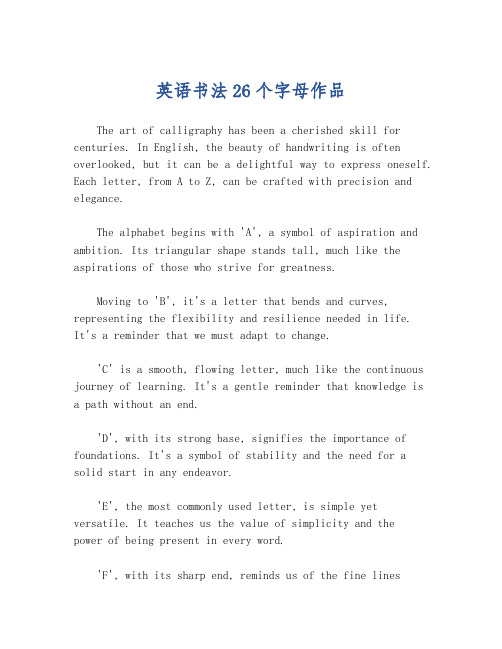
英语书法26个字母作品The art of calligraphy has been a cherished skill for centuries. In English, the beauty of handwriting is often overlooked, but it can be a delightful way to express oneself. Each letter, from A to Z, can be crafted with precision and elegance.The alphabet begins with 'A', a symbol of aspiration and ambition. Its triangular shape stands tall, much like the aspirations of those who strive for greatness.Moving to 'B', it's a letter that bends and curves, representing the flexibility and resilience needed in life.It's a reminder that we must adapt to change.'C' is a smooth, flowing letter, much like the continuous journey of learning. It's a gentle reminder that knowledge is a path without an end.'D', with its strong base, signifies the importance of foundations. It's a symbol of stability and the need for a solid start in any endeavor.'E', the most commonly used letter, is simple yet versatile. It teaches us the value of simplicity and thepower of being present in every word.'F', with its sharp end, reminds us of the fine linesthat separate success from failure. It's a lesson in precision and focus.'G', with its loop and tail, is a letter that signifies generosity and grace. It's a reminder to give freely and to move with ease.'H' stands tall and straight, a symbol of honesty and integrity. It's a reminder to stand firm in our beliefs and values.'I', the smallest letter, represents individuality. It's a symbol of the unique spark that resides in each of us.'J', with its downward stroke, reminds us of the importance of humility. It's a lesson in staying grounded despite our achievements.'K', a letter with a sharp corner, signifies the need for decisiveness. It's a reminder to make choices with clarity and conviction.'L', with its long tail, represents the length of our journey. It's a symbol of the road ahead and the need for patience.'M', a mountainous letter, signifies the challenges we face. It's a reminder that we must rise above our obstacles.'N', with its double hump, reminds us of the ups and downs of life. It's a symbol of resilience and the ability tobounce back.'O', a perfect circle, represents unity and wholeness. It's a reminder that we are all connected.'P', with its sharp peak, signifies the importance of pride. It's a lesson in taking pride in our work and achievements.'Q', a quirky letter, reminds us of the importance of uniqueness. It's a symbol of embracing our individuality.'R', with its curvy tail, signifies the twists and turns of life. It's a reminder that life is full of surprises.'S', a serpentine letter, represents the winding path of growth. It's a symbol of the continuous journey of self-improvement.'T', a sturdy letter, signifies the importance of truth. It's a reminder to stand firm in what is right.'U', with its open shape, represents the power of unity. It's a symbol of the strength that comes from working together.'V', a letter that points upwards, signifies victory.It's a reminder to keep striving for success.'W', a wave-like letter, reminds us of the waves of change. It's a symbol of the need to embrace change.'X', a letter of mystery, represents the unknown. It's a reminder to be curious and to seek knowledge.'Y', a forked letter, signifies the choices we make. It's a reminder that our decisions shape our future.'Z', the final letter, represents the end of a cycle.It's a symbol of completion and the beginning of a new journey.。
龙年英语书法作品
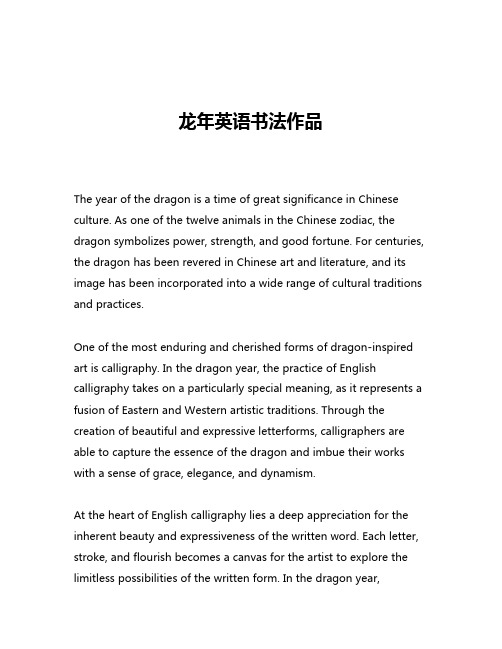
龙年英语书法作品The year of the dragon is a time of great significance in Chinese culture. As one of the twelve animals in the Chinese zodiac, the dragon symbolizes power, strength, and good fortune. For centuries, the dragon has been revered in Chinese art and literature, and its image has been incorporated into a wide range of cultural traditions and practices.One of the most enduring and cherished forms of dragon-inspired art is calligraphy. In the dragon year, the practice of English calligraphy takes on a particularly special meaning, as it represents a fusion of Eastern and Western artistic traditions. Through the creation of beautiful and expressive letterforms, calligraphers are able to capture the essence of the dragon and imbue their works with a sense of grace, elegance, and dynamism.At the heart of English calligraphy lies a deep appreciation for the inherent beauty and expressiveness of the written word. Each letter, stroke, and flourish becomes a canvas for the artist to explore the limitless possibilities of the written form. In the dragon year,calligraphers are challenged to push the boundaries of their craft, to experiment with new techniques and styles, and to create works that truly capture the spirit of this auspicious season.One of the most striking aspects of English calligraphy in the dragon year is the way in which it blends Western and Eastern aesthetic sensibilities. The graceful curves and flowing lines of traditional Chinese calligraphy are seamlessly combined with the more angular and structured forms of the English alphabet, creating a unique and captivating hybrid that is both visually striking and emotionally evocative.Through the use of bold strokes, dramatic flourishes, and intricate details, calligraphers are able to imbue their works with a sense of power and vitality that is reminiscent of the dragon itself. The interplay of light and shadow, the play of positive and negative space, and the careful balance of form and function all come together to create pieces that are both visually stunning and deeply meaningful.But the power of English calligraphy in the dragon year extends far beyond the realm of pure aesthetics. These works of art also serve as a powerful means of self-expression, allowing calligraphers to channel their creativity, their emotions, and their deepest thoughts and aspirations into the creation of something truly remarkable.Whether it is a simple word or phrase, or a more elaborate and complex composition, each calligraphic work becomes a unique and personal statement, a testament to the artist's skill, vision, and inner world. Through the act of writing, calligraphers are able to tap into a wellspring of inspiration and to unlock the hidden depths of their own creative potential.Moreover, the practice of English calligraphy in the dragon year also serves as a powerful tool for cultural exchange and cross-pollination. As calligraphers from around the world come together to explore and experiment with this ancient art form, they are able to share their unique perspectives, techniques, and approaches, and to learn from one another in ways that truly enrich and expand the field.Whether it is through the creation of collaborative works, the hosting of workshops and exhibitions, or the simply the exchange of ideas and inspiration, the world of English calligraphy in the dragon year is a dynamic and ever-evolving landscape, one that is marked by a spirit of openness, creativity, and mutual understanding.At the same time, the practice of English calligraphy in the dragon year also serves as a powerful means of cultural preservation and transmission. By embracing and preserving the traditions of this ancient art form, calligraphers are able to ensure that the rich andvibrant legacy of the dragon will continue to be celebrated and cherished for generations to come.Through the creation of beautiful and evocative works of art, calligraphers are able to capture the essence of the dragon and to share it with the world. Whether it is through the creation of stunning scrolls, the design of elegant invitations, or the simple act of inscribing a meaningful quote or phrase, the art of English calligraphy in the dragon year serves as a powerful testament to the enduring power and beauty of the written word.In the end, the practice of English calligraphy in the dragon year is not just about the creation of beautiful and visually striking works of art. It is also about the cultivation of a deep and abiding connection to the rich cultural heritage of China, and the celebration of the timeless power and majesty of the dragon. Through the art of calligraphy, calligraphers are able to tap into the very heart of this auspicious and transformative season, and to share their passion and creativity with the world.。
横水体英语书法范文

横水体英语书法范文Yokoyama Taikan: Preserving the Essence of Traditional Japanese Painting.Yokoyama Taikan, renowned as one of the preeminent masters of Nihonga (Japanese-style painting), dedicated his life to preserving and revitalizing the traditional art form. His profound understanding of Japanese aesthetics and his unwavering commitment to innovation cemented his legacy as a trailblazing figure in the world of art.Early Life and Training.Born in 1868 in Mito, Japan, Taikan exhibited an early aptitude for art. At the age of 16, he enrolled at the Tokyo School of Fine Arts, where he studied under renowned painters such as Takahashi Yuichi and Kawabata Gyokusho. During his time at the academy, Taikan immersed himself in the study of classical Japanese painting techniques, absorbing the principles of line, brushwork, andcomposition that had been passed down through centuries of tradition.Artistic Breakthroughs.Upon graduating from the Tokyo School of Fine Arts, Taikan embarked on a prolific career that spanned over six decades. He garnered widespread acclaim for his masterful depictions of landscapes, nature, and historical scenes. Taikan's works were characterized by their bold brushstrokes, vibrant colors, and a profound sense of tranquility.One of his most famous paintings, "Morning at Kiyomizu Temple," showcases his exceptional ability to capture the ethereal beauty of the natural world. The painting depicts the majestic Kiyomizu Temple nestled amidst the mist-shrouded hills of Kyoto. Taikan's skillful use of ink and wash techniques creates a sense of depth and atmosphere, inviting viewers to immerse themselves in the serene beauty of the scene.Influence of Buddhism and Zen Aesthetics.Taikan was deeply influenced by Buddhism and Zen aesthetics, which permeated his artistic style. He believed that the ultimate goal of painting was to express the inner spirit and essence of nature. This philosophy is evident in his works, which often evoke a sense of stillness, contemplation, and the interconnectedness of all things.Taikan's artistic vision extended beyond traditional Japanese painting. He actively sought to incorporate Western elements into his works, creating a unique fusion of Eastern and Western influences. This groundbreaking approach challenged the boundaries of traditional Nihonga and opened up new possibilities for artistic expression.Preservation of Traditional Techniques.Despite his embrace of innovation, Taikan remained steadfast in his commitment to preserving traditional Japanese painting techniques. He recognized the importance of safeguarding the cultural heritage that had been passeddown through generations.Taikan played a pivotal role in establishing the Nihon Bijutsuin (Japan Art Institute) in 1898. The institute aimed to promote and protect traditional Japanese art and to foster the development of new talents. Taikan served as the president of the institute for many years, providing guidance and mentorship to aspiring artists.Legacy and Impact.Yokoyama Taikan's profound impact on the art world cannot be overstated. He was instrumental in revitalizing the practice of Nihonga and elevating it to new heights. His unique blend of tradition and innovation inspired countless artists and left an enduring mark on the history of Japanese art.Taikan's works continue to be exhibited in prestigious galleries and museums around the world. His legacy lives on through the numerous students and followers who continue to draw inspiration from his teachings and artistic vision.Yokoyama Taikan's unwavering commitment to preserving the essence of traditional Japanese painting has ensured that this timeless art form will continue to thrive for generations to come.。
英语书法作品 美文
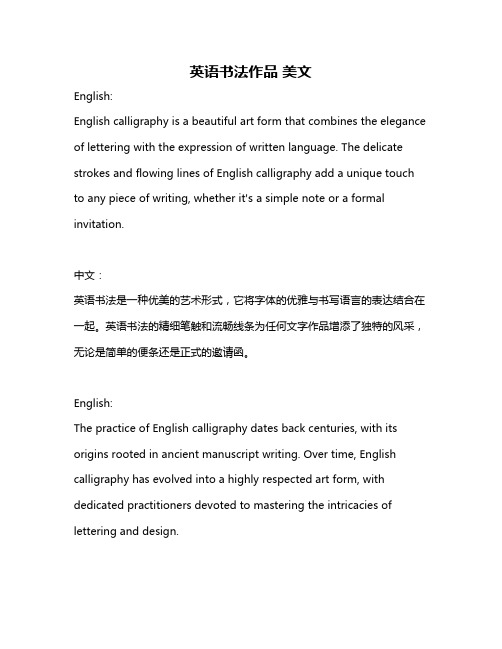
英语书法作品美文English:English calligraphy is a beautiful art form that combines the elegance of lettering with the expression of written language. The delicate strokes and flowing lines of English calligraphy add a unique touch to any piece of writing, whether it's a simple note or a formal invitation.中文:英语书法是一种优美的艺术形式,它将字体的优雅与书写语言的表达结合在一起。
英语书法的精细笔触和流畅线条为任何文字作品增添了独特的风采,无论是简单的便条还是正式的邀请函。
English:The practice of English calligraphy dates back centuries, with its origins rooted in ancient manuscript writing. Over time, English calligraphy has evolved into a highly respected art form, with dedicated practitioners devoted to mastering the intricacies of lettering and design.中文:英语书法的实践可以追溯到数个世纪以前,其起源可以追溯到古代手稿写作。
随着时间的推移,英语书法已经发展成为一种备受尊敬的艺术形式,有专门的从业者致力于掌握字体和设计的复杂技巧。
English:One of the key aspects of English calligraphy is the attention to detail in each stroke of the pen. Practitioners spend hours perfecting their technique, ensuring that every curve and line is executed with precision and grace. This dedication to craftsmanship is evident inthe final product, where even the simplest of words can appear like a work of art.中文:英语书法的关键之一是对每一笔的细节和精心的关注。
六年级英语上册书法作品内容
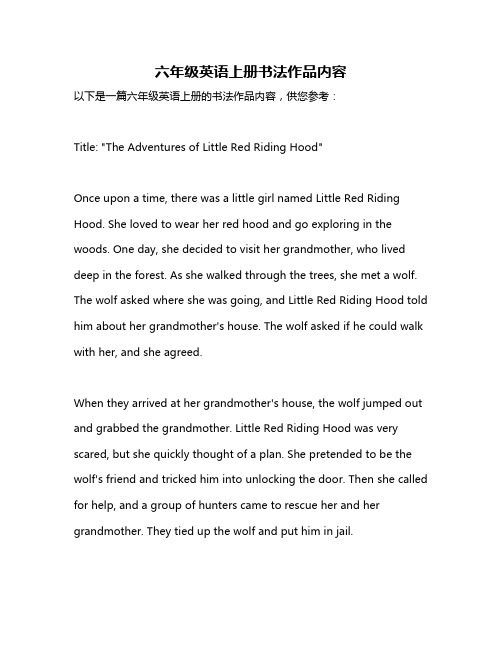
六年级英语上册书法作品内容以下是一篇六年级英语上册的书法作品内容,供您参考:Title: "The Adventures of Little Red Riding Hood"Once upon a time, there was a little girl named Little Red Riding Hood. She loved to wear her red hood and go exploring in the woods. One day, she decided to visit her grandmother, who lived deep in the forest. As she walked through the trees, she met a wolf. The wolf asked where she was going, and Little Red Riding Hood told him about her grandmother's house. The wolf asked if he could walk with her, and she agreed.When they arrived at her grandmother's house, the wolf jumped out and grabbed the grandmother. Little Red Riding Hood was very scared, but she quickly thought of a plan. She pretended to be the wolf's friend and tricked him into unlocking the door. Then she called for help, and a group of hunters came to rescue her and her grandmother. They tied up the wolf and put him in jail.From then on, Little Red Riding Hood learned to be careful when meeting strangers and to always stay alert. She also learned that with courage and smarts, she could overcome any danger. And so the story of Little Red Riding Hood teaches us an important lesson about safety and bravery.这只是一个简单的示例,您可以根据需要进行修改和调整。
关于英语书法比赛的美篇
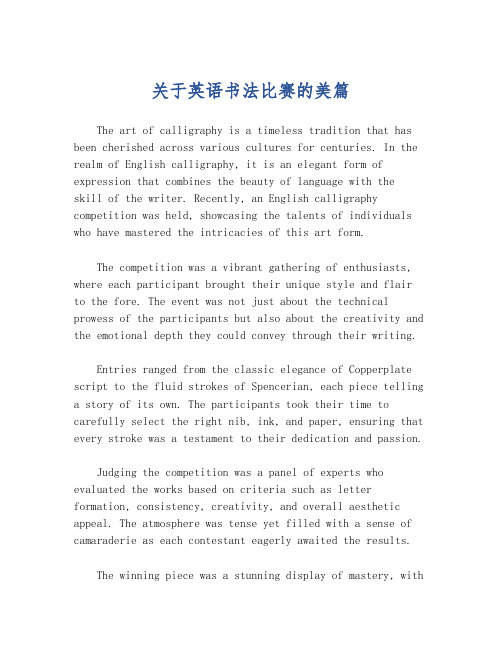
关于英语书法比赛的美篇The art of calligraphy is a timeless tradition that has been cherished across various cultures for centuries. In the realm of English calligraphy, it is an elegant form of expression that combines the beauty of language with theskill of the writer. Recently, an English calligraphy competition was held, showcasing the talents of individuals who have mastered the intricacies of this art form.The competition was a vibrant gathering of enthusiasts, where each participant brought their unique style and flair to the fore. The event was not just about the technical prowess of the participants but also about the creativity and the emotional depth they could convey through their writing.Entries ranged from the classic elegance of Copperplate script to the fluid strokes of Spencerian, each piece telling a story of its own. The participants took their time to carefully select the right nib, ink, and paper, ensuring that every stroke was a testament to their dedication and passion.Judging the competition was a panel of experts who evaluated the works based on criteria such as letter formation, consistency, creativity, and overall aesthetic appeal. The atmosphere was tense yet filled with a sense of camaraderie as each contestant eagerly awaited the results.The winning piece was a stunning display of mastery, witheach letter perfectly formed and the composition harmoniously balanced. The winner was not only applauded for their technical skill but also for the emotional resonance their piece evoked.This English calligraphy competition was more than just a contest; it was a celebration of the written word and the artists who bring it to life. It was a reminder that in an age dominated by digital communication, the art of handwriting still holds a special place in our hearts and minds. The competition served to inspire and encourage others to explore and appreciate the beauty of English calligraphy.。
美国国鸟白头海雕英语作文
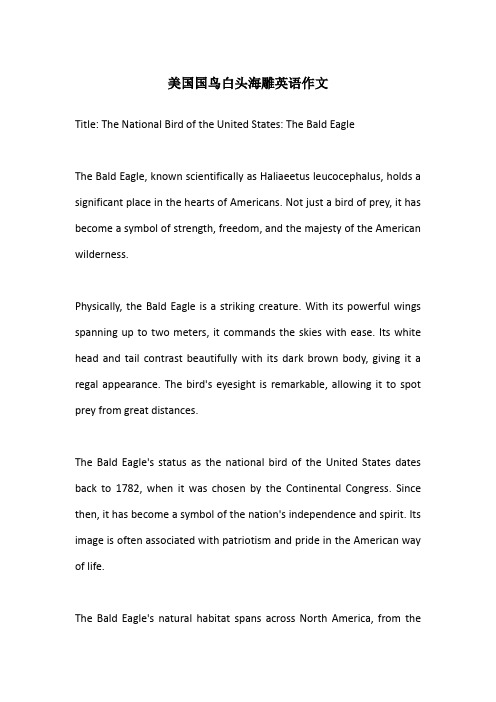
美国国鸟白头海雕英语作文Title: The National Bird of the United States: The Bald EagleThe Bald Eagle, known scientifically as Haliaeetus leucocephalus, holds a significant place in the hearts of Americans. Not just a bird of prey, it has become a symbol of strength, freedom, and the majesty of the American wilderness.Physically, the Bald Eagle is a striking creature. With its powerful wings spanning up to two meters, it commands the skies with ease. Its white head and tail contrast beautifully with its dark brown body, giving it a regal appearance. The bird's eyesight is remarkable, allowing it to spot prey from great distances.The Bald Eagle's status as the national bird of the United States dates back to 1782, when it was chosen by the Continental Congress. Since then, it has become a symbol of the nation's independence and spirit. Its image is often associated with patriotism and pride in the American way of life.The Bald Eagle's natural habitat spans across North America, from thecoastlines to the inland lakes and rivers. It is a top predator, preying on fish, birds, and small mammals. Its hunting skills and prowess in the air make it a formidable opponent.Unfortunately, in the 20th century, the Bald Eagle faced significant threats to its survival. Habitat loss, pollution, and the use of pesticides nearly brought the species to the brink of extinction. However, thanks to conservation efforts and the protection of its natural habitat, the Bald Eagle has made a remarkable recovery.Today, the Bald Eagle is a thriving species, with its numbers increasing steadily. Its return to abundance is a testament to the importance of conservation and the resilience of nature.In conclusion, the Bald Eagle is not just a bird; it is a symbol of the United States. Its image represents the strength, freedom, and spirit of the American people. Its recovery from near extinction is a reminder of the importance of protecting our natural heritage for future generations.翻译:美国国鸟:白头海雕白头海雕,科学名称为Haliaeetus leucocephalus,在美国人民心中占有重要地位。
好看的英文书法
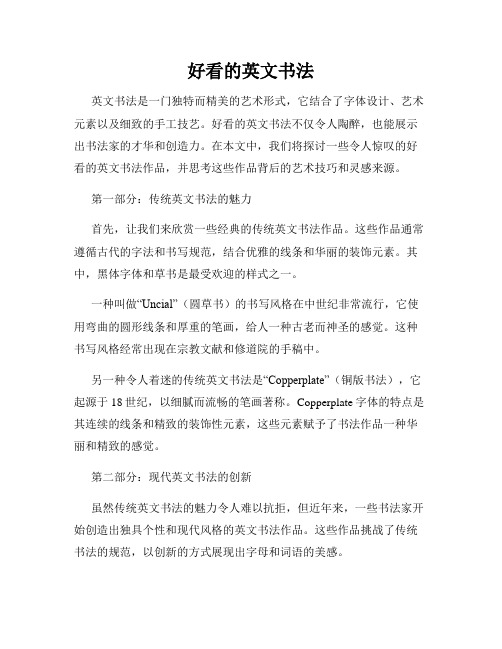
好看的英文书法英文书法是一门独特而精美的艺术形式,它结合了字体设计、艺术元素以及细致的手工技艺。
好看的英文书法不仅令人陶醉,也能展示出书法家的才华和创造力。
在本文中,我们将探讨一些令人惊叹的好看的英文书法作品,并思考这些作品背后的艺术技巧和灵感来源。
第一部分:传统英文书法的魅力首先,让我们来欣赏一些经典的传统英文书法作品。
这些作品通常遵循古代的字法和书写规范,结合优雅的线条和华丽的装饰元素。
其中,黑体字体和草书是最受欢迎的样式之一。
一种叫做“Uncial”(圆草书)的书写风格在中世纪非常流行,它使用弯曲的圆形线条和厚重的笔画,给人一种古老而神圣的感觉。
这种书写风格经常出现在宗教文献和修道院的手稿中。
另一种令人着迷的传统英文书法是“Copperplate”(铜版书法),它起源于18世纪,以细腻而流畅的笔画著称。
Copperplate字体的特点是其连续的线条和精致的装饰性元素,这些元素赋予了书法作品一种华丽和精致的感觉。
第二部分:现代英文书法的创新虽然传统英文书法的魅力令人难以抗拒,但近年来,一些书法家开始创造出独具个性和现代风格的英文书法作品。
这些作品挑战了传统书法的规范,以创新的方式展现出字母和词语的美感。
一个例子是“Modern Calligraphy”(现代书法),它结合了传统书法的基本技巧和当代设计感。
现代书法的艺术家常常运用水墨、彩笔或者荧光笔等不同的材料,创造出各种各样的字体和效果。
这种书写风格强调字母形状的变化和独特的装饰元素,以及艺术家个人的表达和创新。
另一个创新的英文书法是“Typography”(排版书法),它结合了书法艺术和平面设计的原则。
排版书法的作品通常在计算机上设计,然后通过打印或者刻字等方式呈现。
这种书写风格注重字母形状、版式和配色的设计,使得书法作品更具现代感和时尚感。
总结:好看的英文书法既有传统的魅力,又有现代的创新。
无论是传统的圆草书和铜版书法,还是现代的现代书法和排版书法,每一种书写风格都有其独特的魅力和艺术价值。
《The Grateful Crane美丽的仙鹤》英语美文欣赏
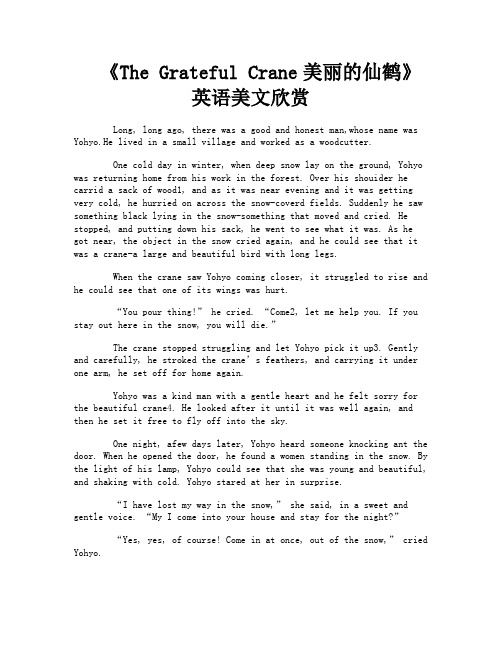
《The Grateful Crane美丽的仙鹤》英语美文欣赏Long, long ago, there was a good and honest man,whose name was Yohyo.He lived in a small village and worked as a woodcutter.One cold day in winter, when deep snow lay on the ground, Yohyo was returning home from his work in the forest. Over his shouider he carrid a sack of wood1, and as it was near evening and it was getting very cold, he hurried on across the snow-coverd fields. Suddenly he saw something black lying in the snow-something that moved and cried. He stopped, and putting down his sack, he went to see what it was. As he got near, the object in the snow cried again, and he could see that it was a crane-a large and beautiful bird with long legs.When the crane saw Yohyo coming closer, it struggled to rise and he could see that one of its wings was hurt.“You pour thing!” he cried. “Come2, let me help you. If you stay out here in the snow, you will die.”The crane stopped struggling and let Yohyo pick it up3. Gently and carefully, he stroked the crane’s feat hers, and carrying it under one arm, he set off for home again.Yohyo was a kind man with a gentle heart and he felt sorry for the beautiful crane4. He looked after it until it was well again, and then he set it free to fly off into the sky.One night, afew days later, Yohyo heard someone knocking ant the door. When he opened the door, he found a women standing in the snow. By the light of his lamp, Yohyo could see that she was young and beautiful, and shaking with cold. Yohyo stared at her in surprise.“I have lost my way in the snow,” she said, in a sweet and gentle voice. “My I come into your house and stay for the night?”“Yes, yes, of course! Come in at once, out of the snow,” cried Yohyo.He build up the fire again with fresh wood, and brought the young woman rice an hot soup. Her name was Otsu and she was as king and gentle as Yohyo homself.The next day there was a storm and so Otsu stayed on at the house and Yohyo grew to love her. Otsu, also, loved him for his gentle heart, and soon they were married.Yohyo and Otsu were happy together, although Yohyo earned only a little money and they were very poor. One night, just before New Year’ Eve, they were sitting together as usual, when Otsu noticed that her husband was worrying about something.“My dear husband,” she said. “What are you worrying about? Please tell me.”“Well…” sighed Yohyo. “It is nearly New Year’ Eve, but I cannot make any preparation for the feast because I have no money. I have not even enough money to buy rice and cakes. How I wish I had some money…”Otsu listened to him silently.“Yohyo, I will weave for you,” she said. “You can take the cloth that I weave5 and sell it at the market to earn some money.”“But, please do not look into the other room, while I amwo rking, promise me that you will not look in?”Yohyo promised, and Otsu went into the other room and began to weave some cloth. She was working for hours ang Yohyo get tired of waiting, but he was patient. At last Otsu came out with a piece of beautiful cloth in her hands. It was the most beautiful cloth that Yohyo had ever seen.The next morning he set off to the market in the town, and sold the piece of cloth for a lot of maney. Yohyo had never had so much money in his life. He was very excited and he bought many things with it. Soon, in his excitement, he had spent all the money, so he went home and asked Otsu to weave another piece of cloth. So greedy did he become, that he did not notice that the more she worked, the thinner Otsu became. However, as she loved Yoho very much, she wove new cloth for him every time he asked for it.One day Yohyo asked for some cloth once again, and Otsu said, as usual, “I will weave for you but remember your promise-don’t look into the other room while I am working.”Yohyo promised and sat down to wait but he soon got tierd of waiting for her. He could hear the sound of weaving, and he began to ask himself why he could not look in at Otsu, while she was working. Once he began to have doubts he could not stop himself from looking in.He thought, “Otsu won’t be angry with me if I look in only for a moment.”Finally, he could wait no longer. He crept to the entrance ofthe other room and looked in. Otsu was not there at all! Instead, he saw a very thin crane which wass pulling off its feathers and weaving them into the cloth. Yohyorecognised it as the very same crane whose life he saved so many months ago.He crept away again and sat thinking quietly. He felt very anxious-what would Otsu do, now that he knew her secret?At last the sound of weaving stopped, and Otsu came out of the roomwith two pieces of cloth in her hands.“Yohyo,” she said, sadly. “You have broken your promise to me. Now that you know that I am a crane, I cannot stay here any longer. Take these pieces of cloth, sell one, and keep the other. Perhaps it will remind you of me.”“Please Otsu, don’t leave me,” cried Yohyo. “How can I manage to live without you? I love you!”But Otsu only smiled gently and shook her head.“No, Yohyo,” she said.”I came here to reply you for your kindness to me, and I stayed for love of your gentle heart. But since I have been weaving for you, you have changed and become greedy and hard.”“I must go, goodbye.”“Don’t go, please, Otsu!” cried poor Yohyo. “Don’t l eave me alone! I won’t tell your secret. Iwon’t ask you for any more cloth. Don’t go!”Otsu just smiled sadly again and waving goodbye, she stepped out of the door. At once she changed into a crane and opening her beautiful wings, she flew up into the sky. As Yohyo watched in despair, she rose higher and higher into the sky, until she could be seen no more.Then there was only the sound of Yohyo’ voice calling,”Otsu! Otsu!…”1. a sack of wood 一捆柴2. come在此是语气词,以引起对方注意3. 仙鹤不再挣扎了,听凭Yohyo把它抱起来。
